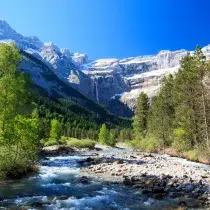
The best of the Hautes-Pyrénées
The 5 themes of your stay in the Hautes Pyrénées
Tourism is the leading economic sector in the Hautes-Pyrénées, thanks to the mountain range, which is a major natural, cultural and sporting asset. The Pyrenees National Park straddles the departments of Hautes-Pyrénées and Pyrénées-Atlantiques. It covers an area of 2,520 km2 and its heartland, mainly around the Vignemale massif, is listed as a UNESCO World Heritage Site for its natural and cultural landscapes.
Natural parks
The Pyrenees also boast eleven regional nature parks(in France, Spain and Andorra) and twenty nature reserves. The Pyrenees are of great importance for the protection and preservation of flora and fauna, as well as for the conservation of cultural areas. The Pibeste-Aoulhet regional nature reserve alone includes the Pic du Midi de Bigorre observatory, the Pont d’Espagne, the Bétharram caves and the Gavarnie glacial cirque, a World Heritage site. All these sites are ideal for nature-related sports (hiking, climbing, caving, mountaineering, cycling, downhill and cross-country skiing – the list goes on!)


The High Pyrenees: natural areas ideal for hiking and cycling
Many valleys
The main valleys to benefit from the renown of national or regional parks are: the Val d’Azun, the Vallée de Luz, the Vallée des Gaves, the Vallée de Cauterets, the Vallée d’Aure and the Massif de Néouvielle, criss-crossed by numerous hiking trails:
- The Aure Valley Trail
- The GR10
- The GR782
- The Pyrenean High Hiking Trail.
In addition to the Gavarnie cirque, the National Park includes the Troumouse and Estaubé glacial cirques, as well as numerous lakes ideal for walks and hikes:
Lac de Lourdes, Lac de Gaube, Lac d’Estaing, Lac de Suyen, Lac d’Orédon, Lac de Cap-de-Long and Lac de l’Oule.
The mountain pass route
Every year, the Pyrenees are the scene of some memorable climbs during the Tour de France. The “route des cols” offers many opportunities to take in exceptional scenery and viewpoints, and for the more courageous, challenging sporting routes. In fact, this route can be travelled by car, motorcycle, bicycle or even on foot…
The route des cols, which links the Atlantic to the Mediterranean, is a signposted route that takes you across the entire Pyrenean mountain range, via mythical cols such as Soulor, Tourmalet, Peyresourde and Aspin.


Cultural spaces
Historical and geological sites in the Hautes-Pyrénées
The exceptional karstic massif of Saint-Pé-de Bigorre is the ideal site for caving, accompanied by professional guides. In fact, 1,580 caves have been identified to date, of which the famous Betharram network, Puts de Tachout, Gouffre du Quéou and perte de Yerse are the most spectacular.
Other geological sites are well worth a visit, even if they are very busy in summer: the Esparros, Labastide, Lourdes, Medous, Troubat, Gargas and Noisetier chasms.
As for prehistoric sites, the Gargas cave is one of Europe’s finest examples of an Upper Paleolithic cave. The Labastide prehistoric site, meanwhile, bears witness to a Magdalenian past, thanks to remains found on site.
Around Lourdes, there are numerous sites where menhirs or dolmens still stand:
Menhirs: Calhaou de Nageou in Agos-Vidalos – Bayle in Arras en Lavedan- Soulor in Arrens-marsous- Peyre Hicadé in Bartrès – Menhir in Bordères Louron- Menhir in Lézignan
Dolmen: La cabane aux loups à Barèges – Pouey Mayou à Bartrès – Le dolmen de Bize
An extraordinary heritage
Numerous sites bear witness to the rich Gallo-Roman heritage of the Hautes Pyrénées. For example, an archaeological trail in Saint-Lézer leads to the ruins of the castrum Bigorra, an ancient motte castrale on the site of the ancient capital of the Biguerres, a people of the Upper Adour Valley, before the rise of Tarbes in the early Middle Ages.
Similarly, the mosaic with the god Ocean from the Saint-Girons estate, on display in the museum area at Montbourget, illustrates the importance of Gallo-Roman occupation of the region. In Tarbes, in the Ormeau district, the ruins of an ancient villa, unearthed in the mid-1980s, are open to the public.
Religious heritage is also very rich, with the Abbey of Saint-Sever-de-Rustan, the Abbey of l’Escaladieu, the Abbey of Saint-Savin-en-Lavedan, the Templar fortified church at Luz-Saint-Sauveur, the Château de Lourdes, the Château de Mauvezin, the Château de Beaucens, Arreau, the former capital of the Quatre-Vallées, and bastides such as Trie-sur-Baïse and Tournay, all remarkable for their medieval architecture.
Don’t miss the Louron valley’s seven Romanesque churches, whose painted interior frescoes have been preserved thanks to the valley’s isolation. They escaped destruction during the Wars of Religion and the French Revolution.
Last but not least, numerous 12th and 13th century watchtowers dot the landscape (Agos-Vidalos, Avezac-Prat-Lahitte, Héchettes for the best preserved).

Thermal baths in the Hautes-Pyrénées
Thermalism and balneotherapy spearhead the appeal of spa towns in the Hautes Pyrénées such as Saint-Lary-Soulan, Luz-Saint-Sauveur, Cauterets, Capvern, Barèges, Bagnères-de-Bigorre and Argelès-Gazost. After skiing in winter and hiking in spring and summer, these activities increase the number of visitors to resorts and towns, especially as balneotherapy facilities have adapted to the new quality requirements of wellness establishments.
Respiratory tracts and rheumatism are the two main pathologies treated in the Hautes Pyrénées. Luz-Saint-Sauveur specializes in phlebology and gynecology, while Capvern treats digestive and urinary disorders, and Bagnères de Bigorre deals with psychosomatic disorders.
Game reserves and parks
In these mountains, where freedom rhymes with wide open spaces, parks have been set up to enable visitors to observe animals native to the Pyrenees at their leisure. Such is the case of the Parc Animalier des Pyrénées in Argelès-Gazost, home to bears, izards and wolves. There’s also the Donjon des aigles in the Château de Beaucens, home to numerous birds of prey; Le parc aux rapaces in Saint-Lanne and Les aigles d’Aure in Arreau. But don’t forget to check out the famous marmots on your hikes!
Book now your rental in the Hautes Pyrénéeses or a camping pitch during your hikes in the Pyrenees at camping le Ruisseau.


